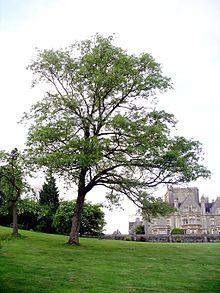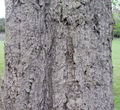| Chinese cork oak | |
|---|---|
 | |
| Chinese cork oak planted at Tortworth Court, England | |
| Scientific classification | |
| Kingdom: | Plantae |
| Clade: | Tracheophytes |
| Clade: | Angiosperms |
| Clade: | Eudicots |
| Clade: | Rosids |
| Order: | Fagales |
| Family: | Fagaceae |
| Genus: | Quercus |
| Subgenus: | Quercus subg. Quercus |
| Section: | Quercus sect. Cerris |
| Species: | Q. variabilis |
| Binomial name | |
| Quercus variabilis | |
| Synonyms[1] | |
| |
Quercus variabilis, the Chinese cork oak, is a species of oak in the section Quercus sect. Cerris, native to a wide area of eastern Asia in southern, central, and eastern China, Taiwan, Japan, and Korea.[2]
Description
Quercus variabilis is a medium-sized to large deciduous tree growing to 25–30 metres (82–98 ft) tall with a rather open crown, and thick corky bark with deep fissures and marked by sinuous ridges. The leaves are simple, acuminate, variable in size, 8–20 centimetres (3.1–7.9 in) long and 2–8 centimetres (0.79–3.15 in) broad, with a serrated margin with each vein ending in a distinctive fine hair-like tooth; they are green above and silvery below with dense short pubescence.[2]
The flowers are wind-pollinated catkins produced in mid spring, maturing about 18 months after pollination; the fruit is a globose acorn, 1.5–2 centimetres (0.59–0.79 in) diameter, two-thirds enclosed in the acorn cup, which is densely covered in soft 4–8 millimetres (0.16–0.31 in) long 'mossy' bristles.[2][3]
Chinese cork oak planted at Meise, Belgium
Distribution and habitat
Evergreen and deciduous forests; below 3,000 metres (9,800 ft). Anhui, Fujian, Gansu, Guangdong, Guangxi, Guizhou, Hebei, Henan, Hubei, Hunan, Jiangsu, Jiangxi, Liaoning, Shaanxi, Shandong, Shanxi, Sichuan, Taiwan, Yunnan, Zhejiang, Japan and Korea.[2]
Uses
It is cultivated in China to a small extent for cork production, though its yield is lower than that of the related cork oak. It is also occasionally grown as an ornamental tree. For pharmaceutical grade production of Ganoderma lucidum, known in China as ‘the mushroom of immortality,’ the dead wood logs of Q. variabilis are used.[4]
References
- ^ "Quercus variabilis Blume". World Checklist of Selected Plant Families (WCSP). Royal Botanic Gardens, Kew – via The Plant List.
- ^ a b c d Huang, Chengjiu; Zhang, Yongtian; Bartholomew, Bruce. "Quercus variabilis". Flora of China. 4 – via eFloras.org, Missouri Botanical Garden, St. Louis, MO & Harvard University Herbaria, Cambridge, MA.
- ^ Blume, Carl Ludwig von (1850). Museum Botanicum (in Latin). 1. p. 297. doi:10.5962/bhl.title.274.
- ^ Shilin Chen; Jiang Xu; Chang Liu; Yingjie Zhu; David R. Nelson; Shiguo Zhou; Chunfang Li; Lizhi Wang; Xu Guo; Yongzhen Sun; Hongmei Luo; Ying Li; Jingyuan Song; Bernard Henrissat; Anthony Levasseur; Jun Qian; Jianqin Li; Xiang Luo; Linchun Shi; Liu He; et al. (2012). "Genome sequence of the model medicinal mushroom Ganoderma lucidum.". Nature Communications. 3 (913): 913. Bibcode:2012NatCo...3..913C. doi:10.1038/ncomms1923. PMC 3621433. PMID 22735441.

